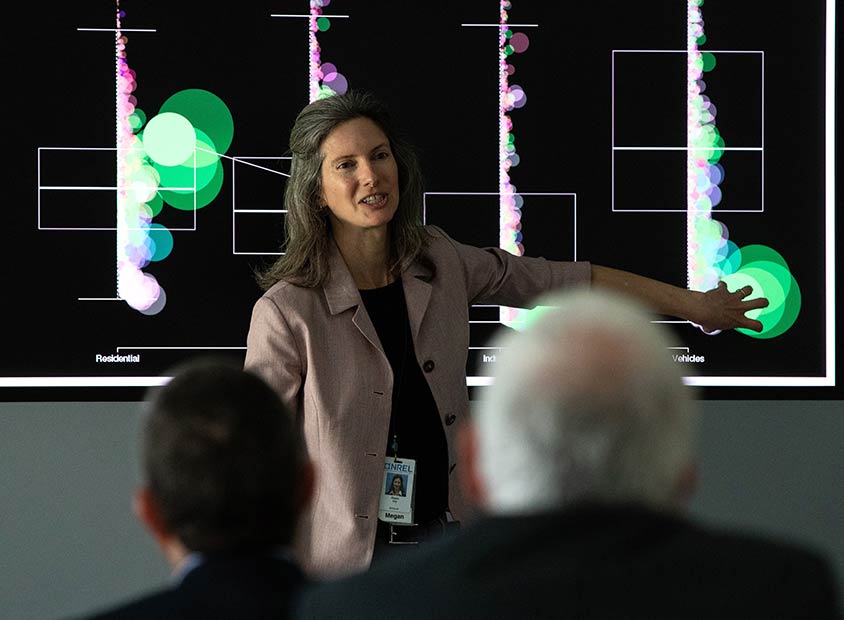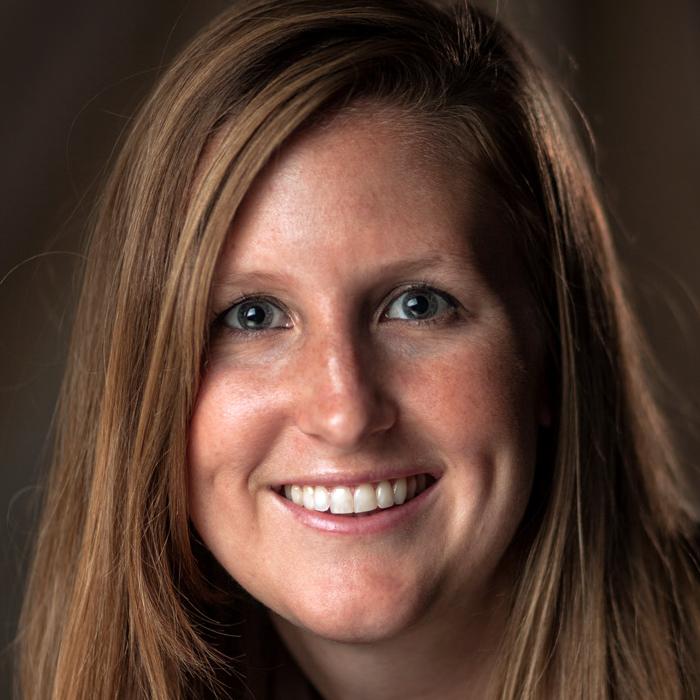NREL Urban Planners Translate Energy Technology into Market Success through Local, State, Federal, and Tribal Governments

Project Leader Megan Day highlights some of the research and technology at the Energy Systems Integration Facility (ESIF) for participants in Energy Innovation Trends - NREL Partner Forum 2018. NREL's collaboration with partners from industry, as well as the U.S. Department of Energy, allows NREL to further the science behind some of the world's greatest energy innovations. Photo by Werner Slocum, NREL
Urban planners have not historically dealt in energy issues, yet clean energy is a growing focus around the world and urban planners' role in energy transitions is evolving as demand increases. Megan Day—one of a growing cohort of urban and regional planners working at the U.S. Department of Energy's (DOE's) National Renewable Energy Laboratory (NREL)—said she believes urban planners are uniquely suited to provide the technical assistance required to apply integrated energy solutions within local jurisdictions.
Between Day and her colleague Alison Holm, the duo brings nearly two decades of urban planning experience to the table. Their role is much needed and expanding as cities, states, and tribes deploy renewable energy systems and set ambitious clean energy goals.
"Urban planners are generalists," Day said. "They help bridge the gap between technical experts, who have specific areas of focus, and local, state, federal, and tribal governments, which may not have energy specialists in-house."
Planners can help translate technical information and make sure no box is left unchecked. Day said that permitting considerations, for instance, come up a lot. Planners also excel at examining land-use systems and energy systems (and their integration) in a holistic way.
"During almost every webinar about solar in your zoning code and land-use planning for solar, someone asks a question about storage," Day said. "How do we plan for storage? We need to be addressing the land-use implications for solar plus storage and other technologies to enable deployment projections to be realized. Every clean energy project needs to be approved by a state or local government, making them critical stakeholders in energy transitions."
Planners with this expertise, such as Day and Holm, can even estimate the time it takes to get projects fully permitted based on the technologies involved.
"Permitting time for wind and solar is very different," Day said. "For wind, it's a five-year development phase. For large-scale solar, it could be as short as six months or as long as two years."
Urban planners operate in complex environments and work with different inputs. Many questions come directly from stakeholders. Planners help make sure stakeholders and researchers are asking the right questions and making all the necessary considerations.
"Energy technologies, solutions, and systems are being implemented within a broader context that includes decisions around housing, transportation, land-use, and economic development," Holm said. "Energy is one among many interrelated sectors that governments deal with. We're bringing the energy considerations to that discussion."
Their role as translators can't be overstated, either. Holm said that urban planners need to be able to consider questions from the perspective of local, state, federal, and tribal governments.

"Communities often have different motivations for exploring energy transformation, and how the problem is articulated can influence both the analysis and the range of solutions," Holm said. "For example, one community might be saying, 'Our core problem is high energy costs for our low-income populations and we're looking at solutions to that problem,' while another might be more focused on strategies to reduce vehicle emissions through electrification. There are many technical aspects to those questions, and the analysis and solutions generated have implications beyond the energy sector. Balancing the specific technical details with the bigger picture can be difficult. That's where urban planners come in."
Additionally, their work on the ground sometimes informs and inspires new work at the laboratory. As an example, Day is currently applying tools and analysis to develop a state and local energy planning tool.
The American Institute of Certified Planners (AICP) is a professional institute that provides the only nationwide, independent verification of planners' qualifications. Holm recently passed AICP's timed, three-and-a-half-hour, 170-question exam, for which most planners study for months. She is now certified along with Day.
"Within the broader planning profession, it's exciting to see energy planning becoming a recognized area of focus and I think it signifies the growing importance of integrating energy considerations into urban and regional systems thinking," Holm said. "Certification lends a sense of credibility when working with communities and other planners. But more importantly, in order to maintain certification, I also need to stay informed about other aspects of planning—trends in housing, transportation, planning ethics. Ultimately, I think this will make me a better energy planner."
Holm and Day both attended University of Colorado, Denver, and earned graduate degrees in urban and regional planning—but followed different routes to get there. Holm was always interested in biology and worked in a biolab during her summers in high school and college. She added a sociology class to fill a requirement and said she really liked the scientific approach to understanding how societies function.
"I think what I became really interested in," Holm said, "was how all these different systems converge in shared spaces—and that's essentially what you get in a city or urban environment."
Knowing she wanted to work before graduate school, she moved to Washington, D.C. There, she worked for the Geothermal Energy Association and the U.S. Energy Association, where she initially focused on domestic geothermal policy. She spent her last few years in D.C. working on geothermal development in East Africa, with a focus on Kenya.
However, Holm said she still had a deep interest in urban environments. She met Day at a conference and was happy to learn NREL employed full-time planners. With Holm's energy background, the laboratory was a perfect fit.
Since joining NREL, Holm said she enjoys being able to work on a variety of projects and across a range of contexts every day.
"Last week I was on back-to-back conference calls with a university in Hawaii, a small city in Illinois, and tri-county region in Western Colorado, all of which are working on different pieces of the energy puzzle," she said. "It's really interesting to explore how we can take data and analysis and apply it in different contexts—and then see how that information gets fed into local processes and, ultimately, into decision-making and implementation."
Holm and Day both said that, for anyone hoping to become a professional urban planner, it's important to integrate energy planning into your studies.
"I would also recommend simply walking around, especially when you're in new places," she said. "You start to notice a lot about how people interact with the built environment."
Day's route to that fortuitous conference meeting with Holm wasn't a straight line, either. Before coming to NREL, she spent six years working as a utility-scale solar photovoltaics developer for a company that did development and design, as well as construction and maintenance. She spent time working as a senior project planner, too—but before graduate school, Day gained experience from a variety of urban environments.
She went to Colorado College before working for a few nonprofits. Her first major job was running a small nonprofit where she worked on community issues, education, and advocacy that included work with local governments. She then went to work on a U.S. Senate campaign which allowed her to interact with organizers and voters. She returned to Colorado College as the community relations manager before taking a year off when her second daughter was born.
Like Holm, Day's path ultimately led her to NREL.
"I work in renewable energy planning to have impact," Day said, "to do what I can to enable a clean energy future."
She said she loves working at NREL because she has access to a deep technical bench of experts in nearly every aspect of clean energy, which she can use to build a team and find advisers.
How Does Urban Planning at NREL Look in Practice?
NREL's urban planners work on a wide array of projects, and for each, must consider the scale, focus, and entities involved when solving their client's energy system puzzle.
At the moment, Day said she's working on an integrated decision-support tool that combines data from across DOE Office of Energy Efficiency and Renewable Energy (EERE) resources to help state, county, and local governments envision and plan for clean energy transitions.
Day and Holm leaned heavily on their urban planning background to develop EERE's Cities-LEAP Data to Decisions series, where they've worked to create pathways from data and analysis to help local governments make important data-driven energy decisions. This project built off the energy profile modeled for every U.S. city (available on EERE's State and Local Energy Data website).
The team has also worked closely with SolSmart, a DOE-funded recognition and technical assistance program that helps communities take steps to reduce solar costs. One community NREL supported through the program was Brownsville, Texas.
"Brownsville was really enthusiastic," Day said. "They had two solar installations, but they wanted more. I helped them through the process of drafting and adopting a solar ordinance. We had webinars and helped train them and reviewed their permitting process and requirements for submitting ground-mounted solar. We worked with them over the course of two years."
While their work is critical to the deployment of energy technologies, Day and Holm said the next step is for urban planners to become more integrated with the research agenda for specific technology applications.
Last Updated May 28, 2025
